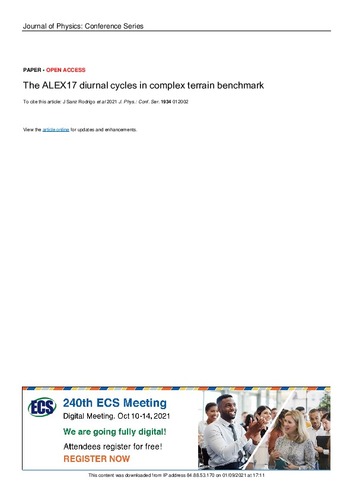Mostra el registre d'ítem simple
The ALEX17 diurnal cycles in complex terrain benchmark
| dc.contributor.author | Sanz Rodrigo, Javier |
| dc.contributor.author | Santos, Pedro |
| dc.contributor.author | Chávez Arroyo, R |
| dc.contributor.author | Avila, Matias |
| dc.contributor.author | Cavar, Dalibor |
| dc.contributor.author | Lehmkuhl Barba, Oriol |
| dc.contributor.author | Owen, Herbert |
| dc.contributor.author | Li, R |
| dc.contributor.author | Tromeur, Eric |
| dc.contributor.other | Barcelona Supercomputing Center |
| dc.date.accessioned | 2021-09-01T16:26:28Z |
| dc.date.available | 2021-09-01T16:26:28Z |
| dc.date.issued | 2021 |
| dc.identifier.citation | Sanz Rodrigo, J. [et al.]. The ALEX17 diurnal cycles in complex terrain benchmark. "Journal of Physics: Conference Series", 2021, |
| dc.identifier.issn | 1742-6588 |
| dc.identifier.issn | 1742-6596 |
| dc.identifier.uri | http://hdl.handle.net/2117/350619 |
| dc.description.abstract | The NEWA ALEX17 experiment was conducted with the objective of characterizing the wind conditions upstream of the Alaiz Test Site for the validation of flow models. From the intensive operational period, a case study has been selected for a Wakebench benchmark consisting of four consecutive days with relatively persistent winds from the North. The validation is centered around a 118-m mast at the Alaiz site and six additional masts located along the valley and at the lee side of a ridge delimiting a 8-km long area of interest. The benchmark is a follow-up of the GABLS3 diurnal cycle benchmark in flat terrain to test mesoscale-to-microscale transient and steady-state modeling methodologies in the assessment of stability-dependent bin-averaged wind conditions. Meso-micro methodologies reduce the wind speed mean bias from 32%, at 3-km mesoscale, to ±5%. Beyond mean bias mitigation, these initial results demonstrate the added value of meso-micro coupling at reproducing non conventional wind conditions at the test site like high-shear low-level jets in stable conditions and negative wind shear in unstable conditions. The benchmark also discusses the challenges of each meso-micro methodology going forward. |
| dc.description.sponsorship | This work was carried out under the umbrella of the International Energy Agency IEA-Wind TCP Task 31 Wakebench, with the support from: MARINE2 (EU grant agreement number 731084) UPWARDS (EU grant agreement number 763990), EoCoE-II (EU grant agreements number 824158 and 828947) and the Mexican Department of Energy, CONACYT-SENER Hidrocarburos grant agreement number B-S-69926 |
| dc.format.extent | 13 p. |
| dc.language.iso | eng |
| dc.publisher | IOP Publishing |
| dc.rights | Attribution 3.0 Spain |
| dc.rights.uri | http://creativecommons.org/licenses/by/3.0/es/ |
| dc.subject | Àrees temàtiques de la UPC::Energies |
| dc.subject.lcsh | Wind power |
| dc.subject.lcsh | Computational fluid dynamics |
| dc.subject.other | Wind conditions |
| dc.subject.other | Flow models |
| dc.subject.other | Meso-micro methodologies |
| dc.title | The ALEX17 diurnal cycles in complex terrain benchmark |
| dc.type | Article |
| dc.subject.lemac | Energia eòlica |
| dc.identifier.doi | 10.1088/1742-6596/1934/1/012002 |
| dc.description.peerreviewed | Peer Reviewed |
| dc.relation.publisherversion | https://iopscience.iop.org/article/10.1088/1742-6596/1934/1/012002 |
| dc.rights.access | Open Access |
| dc.description.version | Postprint (published version) |
| dc.relation.projectid | info:eu-repo/grantAgreement/EC/H2020/824158/EU/Energy Oriented Center of Excellence : toward exascale for energy/EoCoE-II |
| dc.relation.projectid | info:eu-repo/grantAgreement/EC/H2020/828947/EU/Supercomputing and Energy for Mexico/ENERXICO |
| local.citation.publicationName | Journal of Physics: Conference Series |
Fitxers d'aquest items
Aquest ítem apareix a les col·leccions següents
-
Articles de revista [273]


